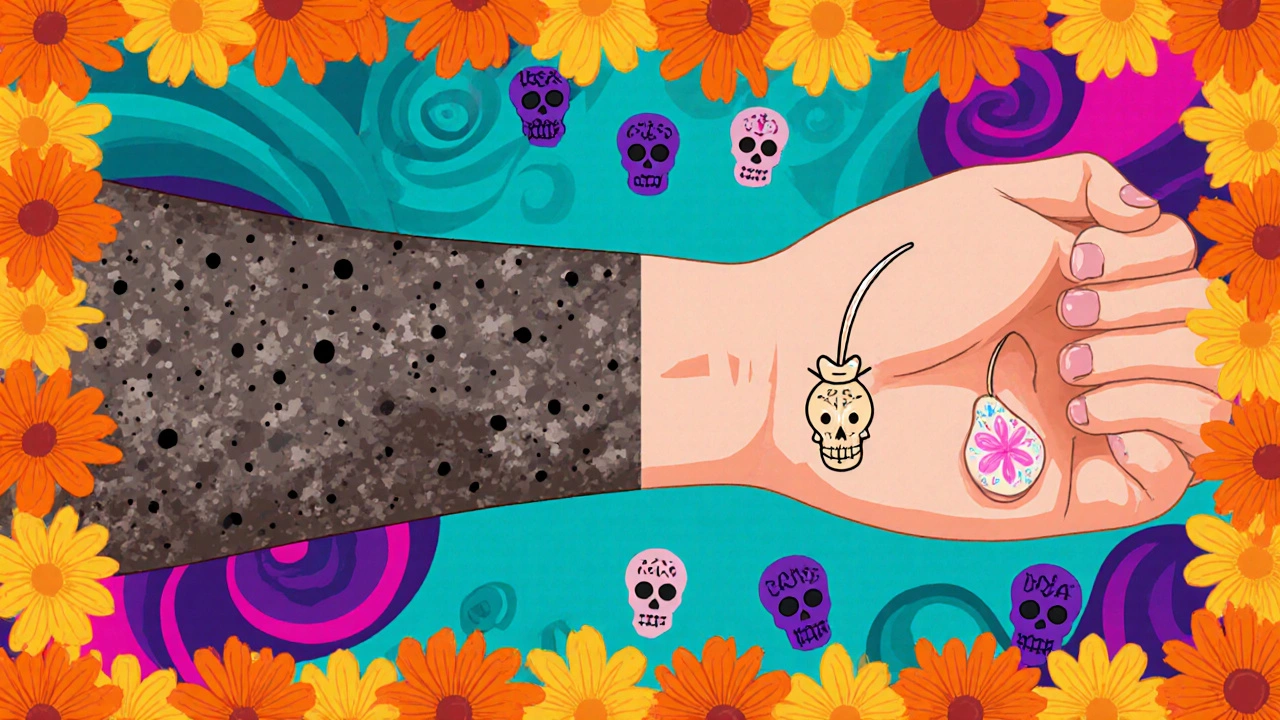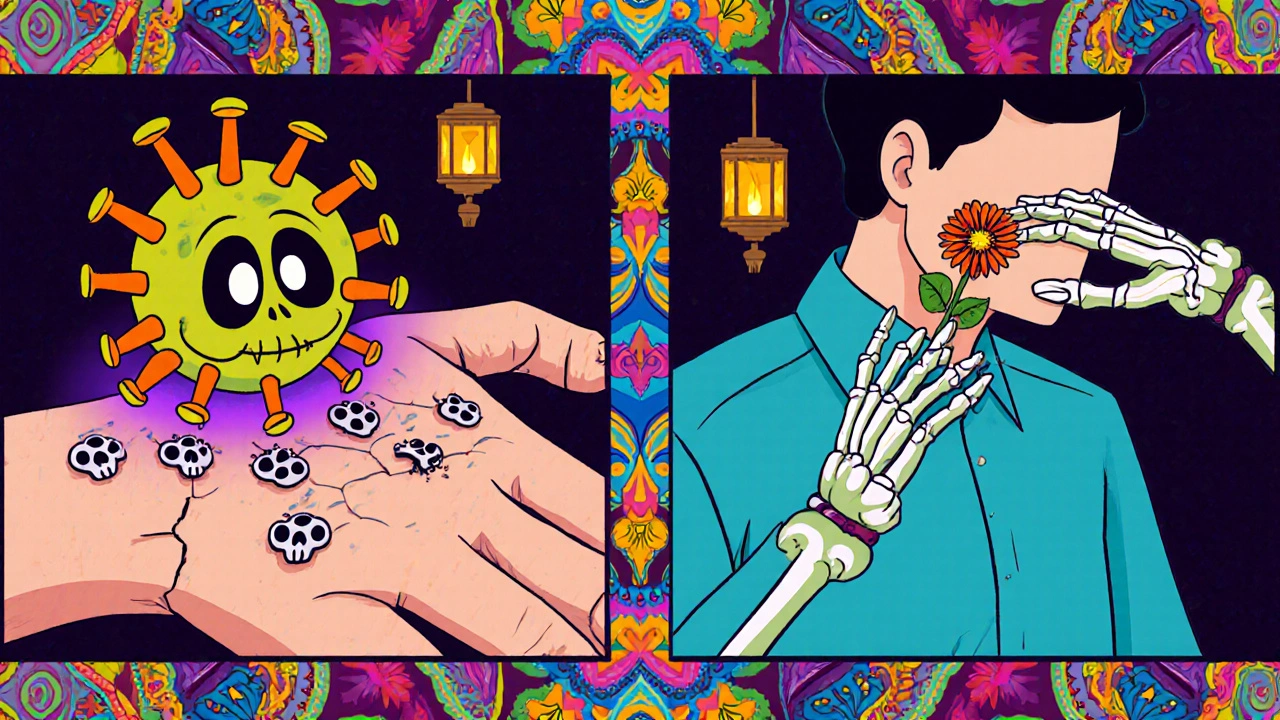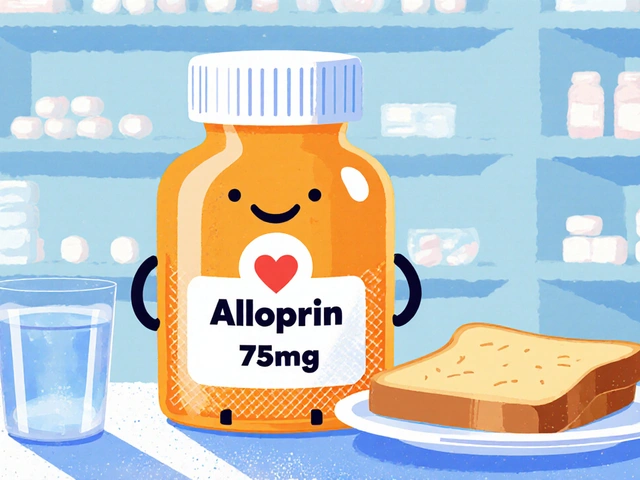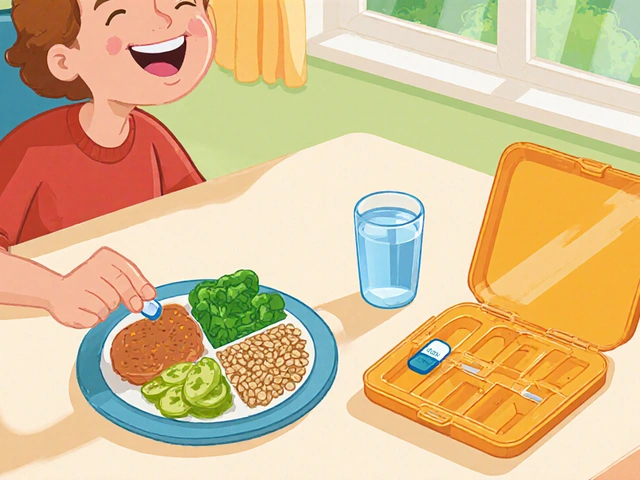
Wart vs Skin Tag Identification Tool
This tool helps you identify whether a skin growth is likely a wart or skin tag based on key characteristics. Answer the questions honestly to get a professional-level assessment.
Ever stared at a bump on your arm and wondered if it’s a wart or a skin tag? You’re not alone - the two look alike enough to cause confusion, yet they have very different causes and care paths. This guide walks you through the tell‑tale signs, explains why they appear, and shows you the safest ways to treat each one.
What is a Wart?
Wart is a benign skin growth caused primarily by human papillomavirus (HPV). The virus infects the top layer of skin, prompting cells to multiply rapidly. Warts can pop up anywhere, but they love the hands, feet, and face because those spots often get tiny cuts that let the virus in.
What is a Skin Tag?
Skin tag is a soft, flesh‑colored papule that forms where skin rubs against skin or clothing. Unlike warts, skin tags aren’t viral; they’re a harmless overgrowth of collagen fibers and blood vessels, usually linked to friction and, sometimes, hormonal changes.
Side‑by‑Side Comparison
| Feature | Wart | Skin tag |
|---|---|---|
| Appearance | Rough, grainy surface; may have black dots (thrombosed vessels) | Smooth, soft, dome‑shaped; same colour as surrounding skin |
| Cause | Human papillomavirus (HPV) infection | Friction, skin‑fold irritation, hormonal factors |
| Typical locations | Hands, fingers, knees, elbows, soles of feet (plantar warts) | Neck, armpits, groin, eyelids, under breasts |
| Feel | Harder, may be tender when pressure is applied | Soft, can be easily moved with a fingertip |
| Treatment options | Cryotherapy, salicylic acid, laser, electrocautery | Snip removal, cryotherapy, cauterisation |
| When to see a professional | Rapid growth, pain, spreading, or if over a joint | Bleeding, irritation, or cosmetic concern |
Why Do Warts Appear? (The HPV Story)
HPV isn’t just the virus behind cervical cancer - dozens of low‑risk strains love tiny cuts on the skin. When the virus reaches a skin cell, it hijacks the cell’s machinery, causing it to produce more copies of itself and, eventually, a raised bump. You’ll often notice warts after a summer of swimming pools, gyms, or communal showers where the virus spreads easily.

Why Do Skin Tags Form?
Skin tags thrive in areas where skin constantly rubs together. Think of the friction between a shirt collar and the back of your neck, or the snug fit of a bra under the arms. Age and genetics also play a role; many people develop a few tags after their thirties, especially if they’re overweight.
Self‑Examination: How to Tell Them Apart
- Look at the surface. If it feels rough or has tiny black dots, you’re likely dealing with a wart.
- Feel the bump. A firm, slightly painful nodule points to a wart; a soft, pliable tag is usually a skin tag.
- Check the location. Tags love creases (neck, armpits); warts love hands, feet, and knees.
- Observe colour. Warts may be darker than skin due to trapped blood vessels; tags match skin tone.
- Consider recent exposure. Recent contact with public showers or nail salons raises the odds of a wart.
When to Call a Dermatologist
If a bump changes size quickly, starts bleeding, or hurts when you move, book an appointment. A dermatologist can confirm the diagnosis with a dermatoscope and recommend treatment that won’t scar or cause infection.
Treatment Options for Warts
Most warts disappear on their own, but if they’re painful or embarrassing, several proven methods exist:
- Cryotherapy: Freezing the wart with liquid nitrogen. A quick, office‑based procedure that often needs a few sessions.
- Salicylic acid (over‑the‑counter): Salicylic acid softens the thickened skin so you can gently file it away. Consistency is key - apply daily for 2‑4 weeks.
- Laser therapy: Targets the blood supply, good for stubborn plantar warts.
- Electrocautery: Burns the wart away with a tiny electric current.
Never pick at a wart. Picking can spread the virus to nearby skin, creating new bumps.
Treatment Options for Skin Tags
Because skin tags are harmless, treatment is usually cosmetic:
- Snipping: A doctor uses sterile scissors to cut the base, then applies pressure to stop bleeding.
- Cryotherapy: Freezing the tag off in seconds, similar to wart removal but with a gentler freeze.
- Cauterisation: A tiny electric probe burns the stalk closed.
- OTC “tag removal” kits: Contain a small applicator that delivers a chemical to dissolve the tag over days. Choose products with clear instructions and avoid sensitive areas like the eyes.
Never try to pull a tag off yourself - it can leave a scar or cause infection.
Prevention Tips for Both
Stopping warts and skin tags before they appear is easier than you think:
- Keep hands clean and dry; use foot powder in shoes to limit moisture.
- Avoid sharing towels, razors, or nail clippers.
- If you frequent communal showers, wear flip‑flops.
- Maintain a healthy weight to reduce skin‑fold friction.
- Moisturise skin in areas prone to folds - hydrated skin is less likely to form tags.
- Consider a HPV vaccine if you’re under 26 and haven’t been vaccinated; it lowers the chance of developing common warts.
Common Misconceptions
“All bumps are cancerous.” - False. Both warts and skin tags are benign.
“Skin tags turn into warts.” - No connection; they arise from different mechanisms.
“Home remedies like duct tape cure warts.” - Some anecdotal success, but scientific support is weak; professional treatment is more reliable.
Quick Decision Checklist
- Rough surface + black dots → Wart
- Soft, skin‑coloured, hangs from a stalk → Skin tag
- Painful when pressure applied → Likely wart
- Located in a skin‑fold → Likely skin tag
- Unsure? Schedule a dermatologist visit.
Can warts spread to other parts of my body?
Yes. The virus can travel via direct contact or through cuts, so avoid picking or scratching them.
Are skin tags a sign of a health problem?
Usually not. They’re common, especially in older adults and people who are overweight. If a tag suddenly grows large or bleeds, see a doctor.
What’s the fastest way to get rid of a wart?
Cryotherapy performed by a dermatologist often shows results after one or two sessions, but over‑the‑counter salicylic acid works if you’re patient.
Can I remove a skin tag at home?
It’s risky. Home kits exist, but improper removal can cause infection or scarring. Professional removal is safest.
Do warts ever turn into skin tags?
No. They have different causes - viruses for warts, friction and genetics for skin tags.





There are 7 Comments
parth gajjar
I have spent countless evenings squinting at a mysterious bump on my arm. The fear of the unknown lingered like a shadow. This guide arrives as a lighthouse in a fog of confusion. It separates the viral tyrant known as a wart from the harmless skin tag. The distinction becomes crystal clear through the table of features. I now understand why warts love the hands and feet. I also see why skin tags cling to the neck and armpits. The explanation of HPV infection feels like a narrative of microscopic war. The description of friction‑induced tags reads like a tale of everyday battles. The self‑examination checklist empowers me to act without panic. Cryotherapy and salicylic acid appear as swords against stubborn warts. Snipping and gentle cauterisation stand as tools for the cosmetic removal of tags. The warning against picking wounds resonates with my own careless habits. Prevention tips such as keeping skin dry and avoiding shared towels are simple yet profound. The misinformation about duct tape cures is debunked with scientific poise. I walk away from this article feeling equipped, confident, and oddly inspired to share this knowledge with anyone who fears a small bump.
Maridel Frey
Understanding the nuances between warts and skin tags empowers readers to make informed health decisions. The checklist provided serves as a practical tool for self‑assessment. When uncertainty persists, seeking a dermatologist ensures accurate diagnosis and safe treatment. By following the preventive measures, many future lesions can be avoided.
Madhav Dasari
Man I remember the panic when I first saw a tiny lump on my neck and thought it was something horrible. This article broke it down in a way that felt like a friendly chat over coffee. The part about HPV being the villain behind warts hit home because I’ve been to a gym locker room a lot. And those skin‑tag facts? Totally relatable – my shirt collar always irritates that spot. The step‑by‑step removal tips gave me confidence to book an appointment instead of freaking out. Plus the prevention hacks are gold for anyone who’s juggling a busy life. Thanks for turning what could be a scary mystery into an easy‑to‑follow guide.
DHARMENDER BHATHAVAR
Warts are viral; skin tags are frictional. Both are benign but require different care. Cryotherapy works well for both with proper technique. Salicylic acid remains the most accessible wart treatment.
Kevin Sheehan
The relentless spread of misinformation about home remedies mirrors a societal aversion to scientific rigor. Duct tape myths persist because they appeal to a desire for effortless solutions. Yet the article’s sober dismissal of such claims underscores the necessity of evidence‑based practice. By championing professional interventions, we confront the complacency that endangers skin health. Let us not forget that true empowerment stems from knowledge, not folklore.
jagdish soni
One cannot ignore the subtle interplay of lifestyle and skin manifestations. The author elegantly ties weight management to reduced friction, thereby preventing tags. Likewise, the emphasis on personal hygiene reflects a deeper understanding of viral transmission. Such insights elevate the discussion beyond mere symptom cataloging.
ashanti barrett
Many feel self‑conscious about visible bumps, fearing judgment from peers. Offering clear, empathetic guidance helps alleviate that anxiety. The article’s balanced tone respects both the medical facts and the emotional impact. Readers gain confidence to seek professional help without stigma.
Write a comment
Your email address will not be published. Required fields are marked *